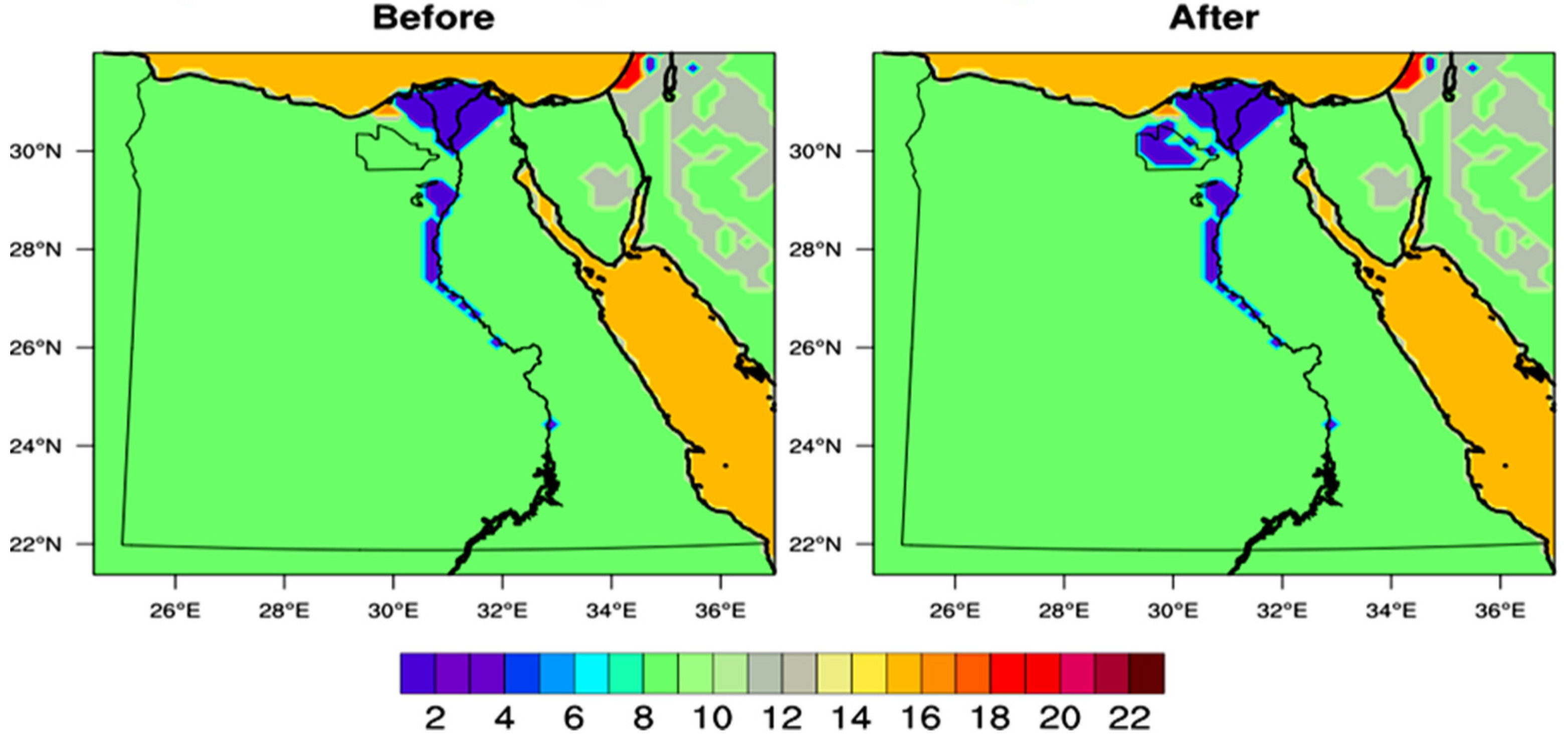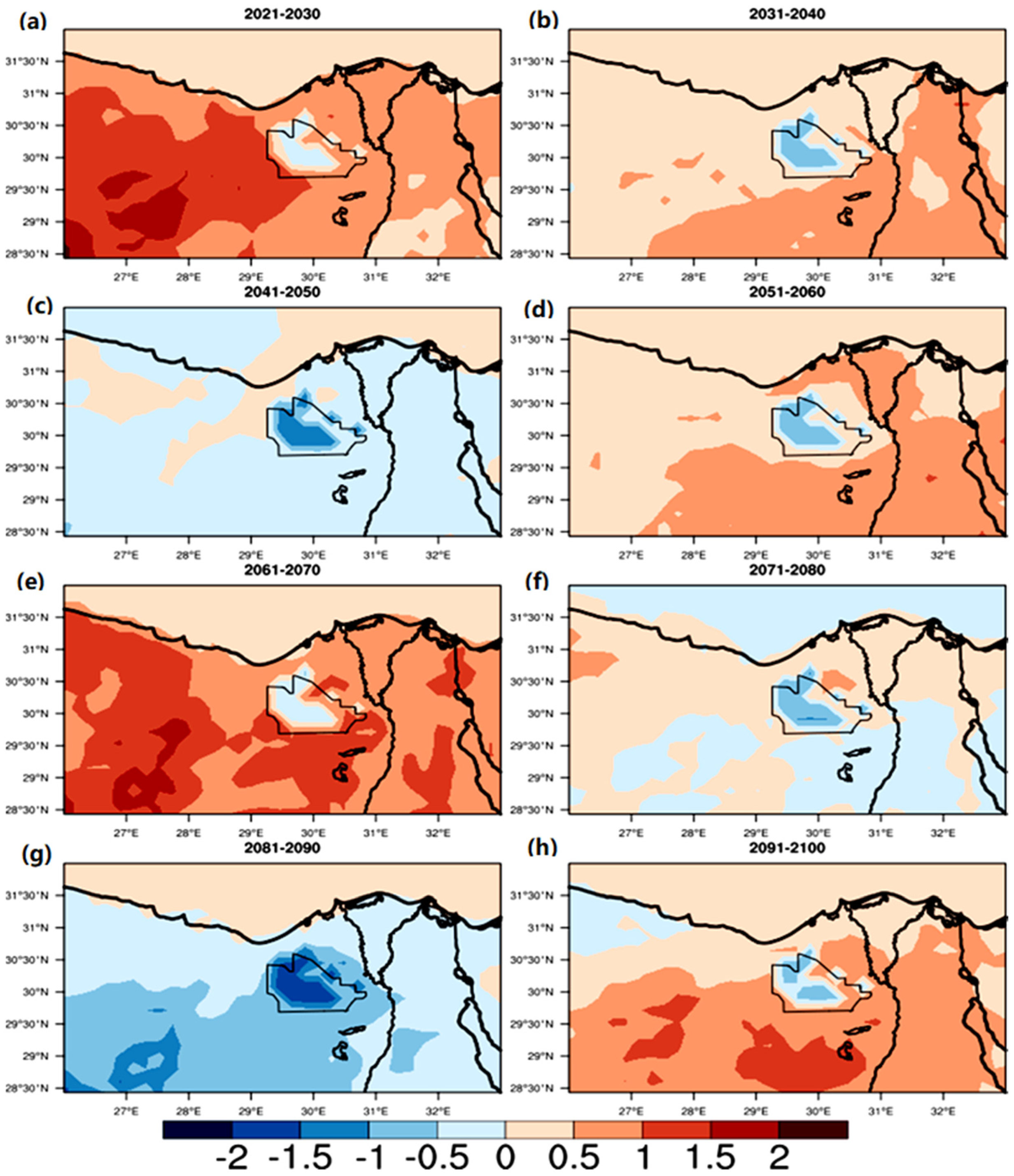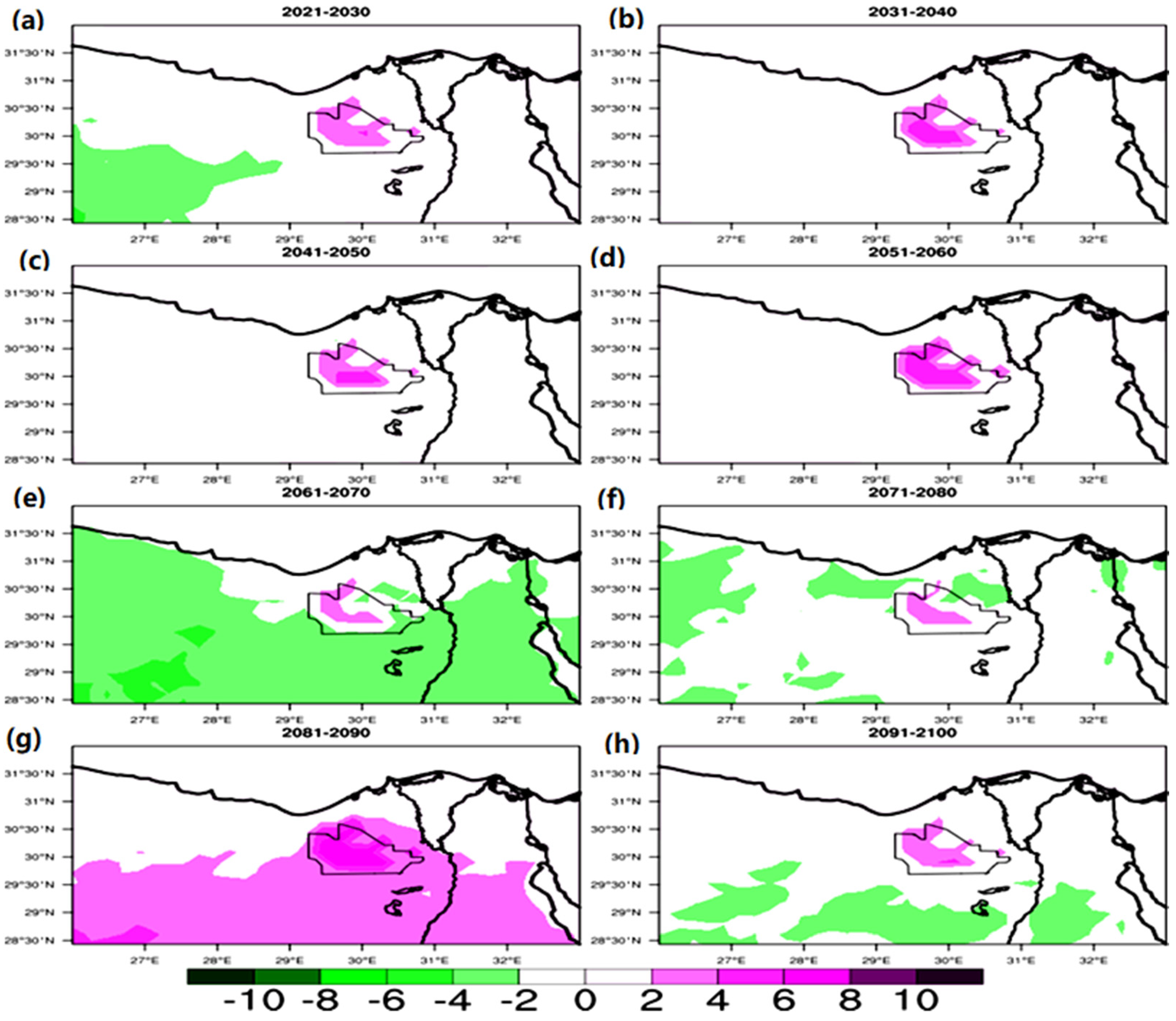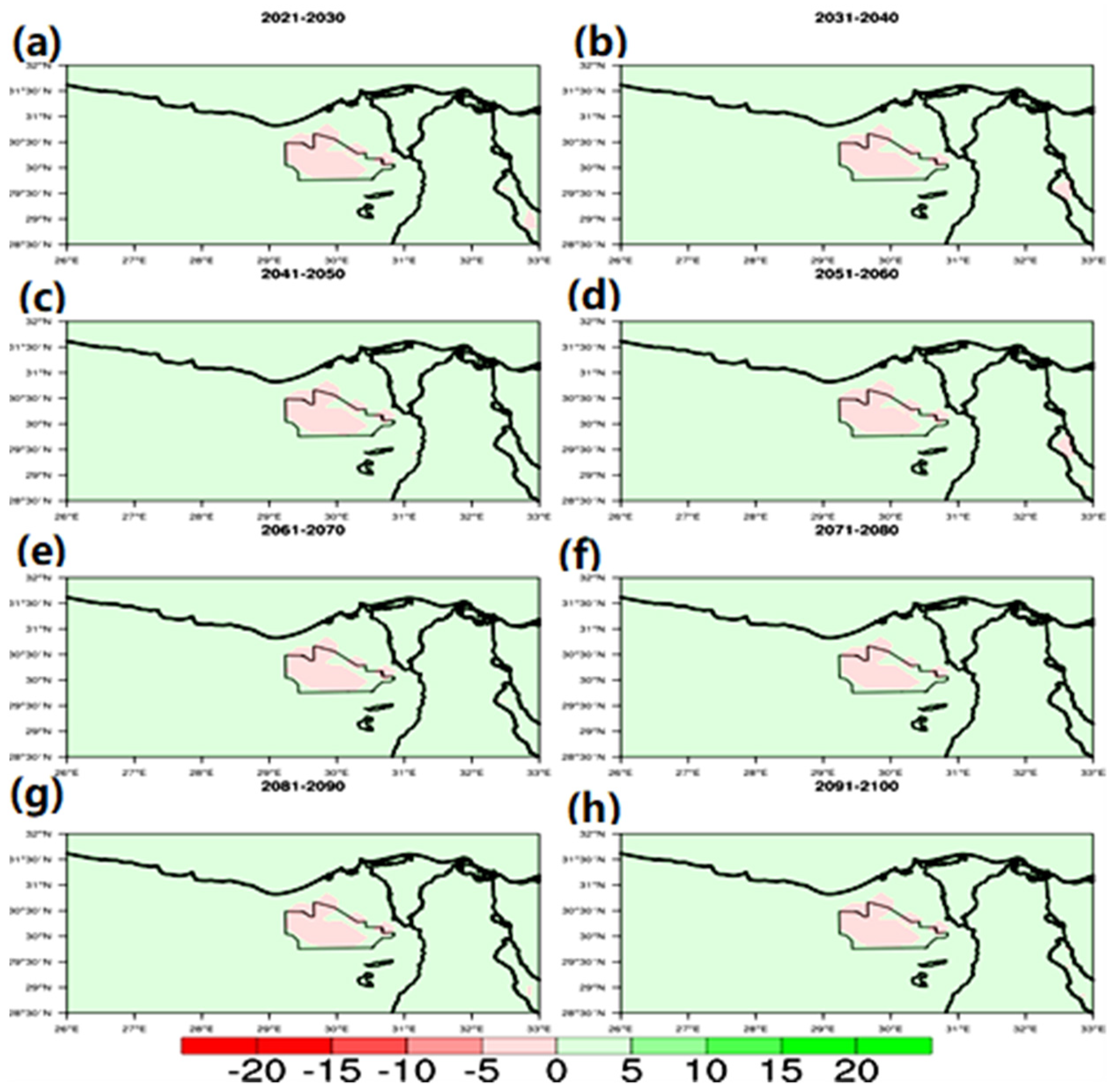Influence of Agricultural Activity on the Surface Climate of New Delta of Egypt Using the RegCM4 †
Abstract
1. Introduction
2. Materials and Methods
2.1. Study Area
2.2. Model Description and Experiment Design
3. Results
4. Discussion and Conclusions
Author Contributions
Funding
Institutional Review Board Statement
Informed Consent Statement
Data Availability Statement
Acknowledgments
Conflicts of Interest
References
- Bonan, G.B. Effects of land use on the climate of the United States. Clim. Chang. 1997, 37, 449–486. [Google Scholar] [CrossRef]
- Feddema, J.; Oleson, K.; Bonan, G.; Mearns, L.; Washington, W.; Meehl, G.; Nychka, D. A comparison of a GCM response to historical anthropo-genic land cover change and model sensitivity to uncertainty in present-day land cover representations. Clim. Dyn. 2005, 25, 581–609. [Google Scholar] [CrossRef]
- Snyder, P.K.; Foley, J.A.; Hitchman, M.H.; Delire, C. Analyzing the effects of complete tropical forest removal on the regional climate using a detailed three-dimensional energy budget: An application to Africa. J. Geophys. Res. 2004, 109. [Google Scholar] [CrossRef]
- Stocker, T.F.; Qin, D.; Plattner, G.-K.; Tignor, M.M.B.; Allen, S.K.; Boschung, J.; Nauels, A.; Xia, Y.; Bex, V.; Midgley, P.M. (Eds.) IPCC 2013: Climate Change 2013: The Physical Science Basis. Contribution of Working Group I to the Fifth Assessment Report of the Intergovernmental Panel on Climate Change; Cambridge University Press: Cambridge, UK; New York, NY, USA, 2013; p. 1535. [Google Scholar]
- Kala, J.; Hirsch, A.L. Could crop albedo modification reduce regional warming over Australia? Weather Clim. Extrem. 2020, 30, 100282. [Google Scholar] [CrossRef]
- Lu, Y.; Kueppers, L.M. Surface energy partitioning over four dominant vegetation types across the United States in a coupled regional climate model (WRF3 CLM3.5). J. Geophys. Res. Atmos. 2012, 117, D06111. [Google Scholar] [CrossRef]
- Anwar, S.A.; Salah, Z.; Khald, W.; Zakey, A.S. Projecting the Potential Evapotranspiration of Egypt Using a High-Resolution Regional Climate Model (RegCM4). Environ. Sci. Proc. 2022, 19, 43. [Google Scholar] [CrossRef]
- Alter, R.E.; Im, E.-S.; Eltahir, E.A.B. Rainfall consistently enhanced around the Gezira Scheme in East Africa due to irrigation. Nat. Geosci. 2015, 8, 763–767. [Google Scholar] [CrossRef]
- Im, E.-S.; Eltahir, E.A.B. Enhancement of rainfall and runoff upstream from irrigation location in a climate model of West Africa. Water Resour. Res. 2014, 50, 8651–8674. [Google Scholar] [CrossRef]
- Im, E.-S.; Marcella, M.P.; Eltahir, E.A.B. Impact of Potential Large-Scale Irrigation on the West African Monsoon and Its Dependence on Location of Irrigated Area. J. Clim. 2014, 27, 994–1009. [Google Scholar] [CrossRef]
- Kang, S.; Eltahir, E.A.B. North China Plain threatened by deadly heatwaves due to climate change and irrigation. Nat. Commun. 2018, 9, 2894. [Google Scholar] [CrossRef]
- Kang, S.; Eltahir, E.A. Impact of Irrigation on Regional Climate Over Eastern China. Geophys. Res. Lett. 2019, 46, 5499–5505. [Google Scholar] [CrossRef]





Disclaimer/Publisher’s Note: The statements, opinions and data contained in all publications are solely those of the individual author(s) and contributor(s) and not of MDPI and/or the editor(s). MDPI and/or the editor(s) disclaim responsibility for any injury to people or property resulting from any ideas, methods, instructions or products referred to in the content. |
© 2022 by the authors. Licensee MDPI, Basel, Switzerland. This article is an open access article distributed under the terms and conditions of the Creative Commons Attribution (CC BY) license (https://creativecommons.org/licenses/by/4.0/).
Share and Cite
Ali, A.H.; Salah, Z.; Anwar, S.A.; Zakey, A.S. Influence of Agricultural Activity on the Surface Climate of New Delta of Egypt Using the RegCM4. Eng. Proc. 2023, 31, 43. https://doi.org/10.3390/ASEC2022-13763
Ali AH, Salah Z, Anwar SA, Zakey AS. Influence of Agricultural Activity on the Surface Climate of New Delta of Egypt Using the RegCM4. Engineering Proceedings. 2023; 31(1):43. https://doi.org/10.3390/ASEC2022-13763
Chicago/Turabian StyleAli, Amani H., Zeinab Salah, Samy Ashraf Anwar, and Ashraf Saber Zakey. 2023. "Influence of Agricultural Activity on the Surface Climate of New Delta of Egypt Using the RegCM4" Engineering Proceedings 31, no. 1: 43. https://doi.org/10.3390/ASEC2022-13763
APA StyleAli, A. H., Salah, Z., Anwar, S. A., & Zakey, A. S. (2023). Influence of Agricultural Activity on the Surface Climate of New Delta of Egypt Using the RegCM4. Engineering Proceedings, 31(1), 43. https://doi.org/10.3390/ASEC2022-13763






